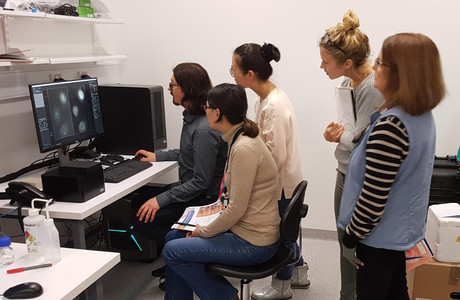Super-resolution microscopy comes to Westmead

The recent installation of an Oxford Nanoimaging single-molecule microscope at the Westmead Research Hub will provide researchers with much-needed super-resolution imaging capabilities. Available in Australia through AXT, the microscope will allow researchers to observe cellular interactions at the nanoscale, giving them greater insights into how diseases such as cancer behave and increasing the chance of developing breakthrough cures.
The Nanoimager is a super-resolution microscope that offers biological researchers a range of imaging modes, including direct stochastic optical reconstruction microscopy (dSTORM) photoactivated localisation microscopy (PALM), total internal reflection (TIRF), highly inclined and laminated optical sheet (HILO) and structural illumination microscopy (SIM) in a single instrument. Other key design features include compact size, internal active vibration damping, a streamlined optical path and a robust design to ensure the most stable of images are produced without the need for optical benches or darkrooms.
“We have been interested in adding super-resolution microscopy capabilities to our facility for some time,” said Dr Laurence Cantrill, an advanced microscopy and imaging specialist at Westmead’s Kids Research, the research arm of the Sydney Children’s Hospitals Network. “Solutions that we had previously looked at were usually too expensive. The Nanoimager was not only affordable, but also compact and futureproof.
“Its flexible design gives us the capability to add new imaging modalities down the track to cater for new research areas that we may not even be aware of yet, making it ideal for a multi-use facility such as ours. Evaluating the system last year, I was convinced that this microscope provided us with a solution that will suit the numerous and varied researchers in our organisation.”
The Nanoimager will be located at the Westmead Research Hub, where it will serve researchers from nearby hospitals and research institutes as well as the University of Sydney. Dr Cantrill noted, “Having the instrument located locally is not only convenient, but also critical for many of the time-sensitive live cell studies that we carry out.”
The user-friendly and robust design makes the microscope suitable for researchers from undergraduate to postdoctoral level, while its simple yet multimodal design makes it valuable for teaching the principles of subdiffraction imaging. Dr Cantrill expects that it will be used by researchers in areas such as:
- cancer research from its origins in telomere dysregulation through to its physiology and processes of invasion and migration
- tracking the herpes simplex virus (HSV-1) in neurons
- looking at damage and repair in cell membranes in muscular dystrophy
- unravelling the early stages of HIV infection.
Dr Cantrill is grateful to the Ian Potter Foundation and a private philanthropist for their financial contributions that helped secure the Nanoimager.
A non-destructive way to locate microplastics in body tissue
Currently available analytical methods either destroy tissue in the body or do not allow...
Rapid imaging method shows how medicine moves beneath the skin
Researchers have developed a rapid imaging technique that allows them to visualise, within...
Fluorescent molecules glow in water, enhancing cell imaging
Researchers have developed a new family of fluorescent molecules that glow in a surprising way,...





